Analysis of the Surface Stereometry of Alloyed Austenitic Steel after Fibre Laser Cutting using Confocal Microscopy
Abstract
1. Introduction
2. Materials and Methods
- Amplitude parameters (Sq, Ssk, Sku, Sp, Sv, Sz, Sa);
- Volume functional parameters (Vm, Vv, Vmp, Vmc, Vvc, Vvv);
- Feature parameters (Spd, Spc, S10z, S5p, S5v, Sda, Sha, Sdv, Shv);
- Other 3D parameters (Smean, Sdar, Spar).
- Distribution parameters—roughness profile (RSm, Rdq);
- Peak parameters—roughness profile (RPc);
- Material ratio parameters—basic profile (Pmr, Pdc);
- Amplitude parameters—profile (Rp, Rv, Rz, Rc, Rt, Ra, Rq, Rsk, Rku).
3. Results and Discussion
4. Conclusions
Author Contributions
Funding
Institutional Review Board Statement
Informed Consent Statement
Data Availability Statement
Conflicts of Interest
References
- Wysmulski, P.; Debski, H. Post-buckling and limit states of composite channel-section profiles under eccentric compression. Compos. Struct. 2020, 245, 112356. [Google Scholar] [CrossRef]
- Borawski, A. Impact of operating time on selected tribological properties of the friction material in the brake pads of passenger cars. Materials 2021, 14, 884. [Google Scholar] [CrossRef] [PubMed]
- Rozylo, P.; Wysmulski, P. Failure analysis of thin-walled composite profiles subjected to axial compression using progressive failure analysis (PFA) and cohesive zone model (CZM). Compos. Struct. 2021, 262, 113597. [Google Scholar] [CrossRef]
- Borawski, A. Testing passenger car brake pad exploitation time’s impact on the values of the coefficient of friction and abrasive wear rate using a pin-on-disc method. Materials 2022, 15, 1991. [Google Scholar] [CrossRef]
- Debski, H.; Rozylo, P.; Wysmulski, P.; Falkowicz, K.; Ferdynus, M. Experimental study on the effect of eccentric compressive load on the stability and load-carrying capacity of thin-walled composite profiles. Compos. Part B Eng. 2021, 226, 109346. [Google Scholar] [CrossRef]
- Sadowski, Ł.; Mathia, T.G. Multi-scale metrology of concrete surface morphology: Fundamentals and specificity. Constr. Build. Mater. 2016, 113, 613–621. [Google Scholar] [CrossRef]
- Thomas, T.R. Rough Surfaces, 2nd ed.; Imperial College Press: London, UK, 1999. [Google Scholar]
- Whitehouse, D.J. Surfaces and their Measurement; Hermes Penton Science: London, UK, 2002. [Google Scholar]
- Garbacz, A.; Courard, L.; Bissonnette, B. A surface engineering approach applicable to concrete repair engineering. Bull. Pol. Acad. Sci. Tech. Sci. 2013, 61, 73–84. [Google Scholar] [CrossRef]
- Krajewski, S.; Nowacki, J. Preparation of aluminium foam edges for welding. Adv. Mater. Sci. 2013, 13, 64–75. [Google Scholar] [CrossRef][Green Version]
- Krajewski, S.; Nowacki, J. Structure of AlSi-SiC composite foams surface formed by mechanical and thermal cutting. Appl. Surf. Sci. 2015, 327, 523–531. [Google Scholar] [CrossRef]
- Gustowski, T.; Kurek, W.; Grzejda, R. Concept of an innovative technological line for the processing of linear profiles. Prod. Eng. Arch. 2023, 29. in press. [Google Scholar]
- Lin, Z.; Hong, M. Femtosecond laser precision engineering: From micron, submicron, to nanoscale. Ultrafast Sci. 2021, 2021, 9783514. [Google Scholar] [CrossRef]
- Liu, X.; Popa, D.; Akhmediev, N. Revealing the transition dynamics from q switching to mode locking in a soliton laser. Phys. Rev. Lett. 2019, 123, 093901. [Google Scholar] [CrossRef] [PubMed]
- Liu, X.; Pang, M. Revealing the buildup dynamics of harmonic mode-locking states in ultrafast lasers. Laser Photonics Rev. 2019, 13, 1800333. [Google Scholar] [CrossRef]
- Yong, J.; Yang, Q.; Hou, X.; Chen, F. Nature-inspired superwettability achieved by femtosecond lasers. Ultrafast Sci. 2022, 2022, 9895418. [Google Scholar] [CrossRef]
- Zhang, C.; Li, X.; Chen, E.; Liu, H.; Shum, P.P.; Chen, X.-H. Hydrazone organics with third-order nonlinear optical effect for femtosecond pulse generation and control in the L-band. Opt. Laser Technol. 2022, 151, 108016. [Google Scholar] [CrossRef]
- Parthiban, A.; Chandrasekaran, M.; Muthuraman, V.; Sathish, S. Optimization of CO2 laser cutting of stainless steel sheet for curved profile. Mater. Today Proc. 2018, 5, 14531–14538. [Google Scholar] [CrossRef]
- Li, M. Evaluation of the effect of process parameters on the cut quality in fiber laser cutting of duplex stainless steel using response surface method (RSM). Infrared Phys. Technol. 2021, 118, 103896. [Google Scholar] [CrossRef]
- Powell, J.; Al-Mashikhi, S.O.; Kaplan, A.F.H.; Voisey, K.T. Fibre laser cutting of thin section mild steel: An explanation of the ‘striation free’ effect. Opt. Laser Technol. 2011, 49, 1069–1075. [Google Scholar] [CrossRef]
- Oh, S.Y.; Shin, J.S.; Park, S.; Kwon, S.; Nam, S.; Kim, T.; Park, H.; Lee, J. Experimental investigation of underwater laser cutting for thick stainless steel plates using a 6-kW fiber laser. Ann. Nucl. Energy 2022, 168, 108896. [Google Scholar] [CrossRef]
- Shin, J.S.; Oh, S.Y.; Park, H.; Kim, T.-S.; Lee, L.; Chung, C.-M.; Lee, J. Underwater cutting of 50 and 60 mm thick stainless steel plates using a 6-kW fiber laser for dismantling nuclear facilities. Opt. Laser Technol. 2019, 115, 1–8. [Google Scholar] [CrossRef]
- Kotadiya, D.J.; Kapopara, J.M.; Patel, A.R.; Dalwadi, C.G.; Pandya, D.H. Parametric analysis of process parameter for laser cutting process on SS-304. Mater. Today Proc. 2018, 5, 5384–5390. [Google Scholar] [CrossRef]
- Nikolidakis, E.; Choreftakis, I.; Antoniadis, A. Experimental investigation of stainless steel SAE304 laser engraving cutting conditions. Machines 2018, 6, 40. [Google Scholar] [CrossRef]
- Beniyash, A.; Klimov, G.; Hassel, T. The use of non-vacuum electron beam (NVEB) technology as an universal manufacturing process for welding and cutting of high-strength steels. J. Phys. Conf. Ser. 2018, 1089, 012012. [Google Scholar] [CrossRef]
- Tomków, J.; Landowski, M.; Fydrych, D.; Rogalski, G. Underwater wet welding of S1300 ultra-high strength steel. Mar. Struct. 2022, 81, 103120. [Google Scholar] [CrossRef]
- Parshin, S.; Levchenko, A.; Wang, P.; Maystro, A. Mathematical analysis of the influence of the flux-cored wire chemical composition on the electrical parameters and quality in the underwater wet cutting. Adv. Mater. Sci. 2021, 21, 77–89. [Google Scholar] [CrossRef]
- Parshin, S.G.; Levchenko, A.M.; Wang, P. Metallurgy and mechanism of underwater wet cutting using oxidizing and exothermic flux-cored wires. Materials 2021, 14, 4655. [Google Scholar] [CrossRef]
- Kim, K.; Song, M.-K.; Lee, S.-J.; Shin, D.; Suh, J.; Kim, J.-D. Fundamental study on underwater cutting of 50 mm-thick stainless steel plates using a fiber laser for nuclear decommissioning. Appl. Sci. 2022, 12, 495. [Google Scholar] [CrossRef]
- Kim, R.; Lee, S.-J.; Choi, J.; Shin, D.; Kim, J.-D. Effect of process variables for reducing assist gas pressure in 50 mm-thick stainless steel underwater laser cutting. Appl. Sci. 2022, 12, 9574. [Google Scholar] [CrossRef]
- PN-EN 1090-2; Execution of Steel Structures and Aluminium Structures, Part 2: Technical Requirements for Steel Structures. Polish Committee for Standardization: Warsaw, Poland, 2018.
- Bursi, O.S.; D’Incau, M.; Zanon, G.; Raso, S.; Scardi, P. Laser and mechanical cutting effects on the cut-edge properties of steel S355N. J. Constr. Steel Res. 2017, 133, 181–191. [Google Scholar] [CrossRef]
- Eltawahni, H.A.; Hagino, M.; Benyounis, K.Y.; Inoue, T.; Olabi, A.G. Effect of CO2 laser cutting process parameters on edge quality and operating cost of AISI316L. Opt. Laser Technol. 2012, 44, 1068–1082. [Google Scholar] [CrossRef]
- Anghel, C.; Gupta, K.; Jen, T.C. Analysis and optimization of surface quality of stainless steel miniature gears manufactured by CO2 laser cutting. Optik 2020, 203, 164049. [Google Scholar] [CrossRef]
- Stournaras, A.; Stavropoulos, P.; Salonitis, K.; Chryssolouris, G. An investigation of quality in CO2 laser cutting of aluminum. CIRP J. Manuf. Sci. Technol. 2009, 2, 61–69. [Google Scholar] [CrossRef]
- Sharifi, M.; Akbari, M. Experimental investigation of the effect of process parameters on cutting region temperature and cutting edge quality in laser cutting of AL6061T6 alloy. Optik 2019, 184, 457–463. [Google Scholar] [CrossRef]
- Zubko, M.; Loskot, J.; Świec, P.; Prusik, K.; Janikowski, Z. Analysis of stainless steel waste products generated during laser cutting in nitrogen atmosphere. Metals 2020, 10, 1572. [Google Scholar] [CrossRef]
- Mahrle, A.; Borkmann, M.; Pfohl, P. Factorial analysis of fiber laser fusion cutting of AISI 304 stainless steel: Evaluation of effects on process performance, kerf geometry and cut edge roughness. Materials 2021, 14, 2669. [Google Scholar] [CrossRef]
- Buj-Corral, I.; Costa-Herrero, L.; Domínguez-Fernández, A. Effect of process parameters on the quality of laser-cut stainless steel thin plates. Metals 2021, 11, 1224. [Google Scholar] [CrossRef]
- Madić, M.; Radovanović, M.; Slatineanu, L. Surface roughness optimalization in CO2 laser cutting by using Taguchi method. UPB Sci. Bull. Ser. D Mech. Eng. 2013, 75, 97–106. [Google Scholar]
- Karthikeyan, R.; Senthilkumar, V.; Thilak, M.; Nagadeepan, A. Application of grey relational analysis for optimization of kerf quality during CO2 laser cutting of mild steel. Mater. Today Proc. 2018, 5, 19209–19215. [Google Scholar] [CrossRef]
- Parthiban, A.; Dhanasekaran, C.; Sivaganesan, S.; Sathish, S. Modeling on surface cut quality of CO2 laser cutting for austenitic stainless steel sheet. Mater. Today Proc. 2020, 21, 823–827. [Google Scholar] [CrossRef]
- Savinkin, V.V.; Vizureanu, P.; Sandu, A.V.; Ratushnaya, T.Y.; Ivanischev, A.A.; Surleva, A. Improvement of the turbine blade surface phase structure recovered by plasma spraying. Coatings 2020, 10, 62. [Google Scholar] [CrossRef]
- Bekmurzayeva, A.; Duncanson, W.J.; Azevedo, H.S.; Kanayeva, D. Surface modification of stainless steel for biomedical applications: Revisiting a century-old material. Mater. Sci. Eng. C 2018, 93, 1073–1089. [Google Scholar] [CrossRef]
- Mat Tahir, N.A.; Liza, S.; Fukuda, K.; Mohamad, S.; Hashimi, M.Z.F.; Yunus, M.S.M.; Yaakob, Y.; Othman, I.S. Surface and tribological properties of oxide films on aluminium alloy through fly-ash reinforcement. Coatings 2022, 12, 256. [Google Scholar] [CrossRef]
- Padgurskas, J.; Rukuiža, R.; Žunda, A. Evaluation of tribological and mechanical properties of carbon steel with fluoroligomeric film at piezoelectric actuator contact. Coatings 2022, 12, 463. [Google Scholar] [CrossRef]
- Khan, M.A.; Gupta, K. Experimental evaluation of surface quality characteristics in laser machining of nickel-based superalloy. Optik 2019, 196, 163199. [Google Scholar]
- PN-EN ISO 4287; Geometrical Product Specifications (GPS), Surface Texture: Profile Method, Terms, Definitions and Surface Texture Parameters. Polish Committee for Standardization: Warsaw, Poland, 1999.
- PN-EN ISO 25178-600; Geometrical Product Specifications (GPS), Surface Texture: Areal, Part 600: Metrological Characteristics for Areal-Topography Measuring Methods. Polish Committee for Standardization: Warsaw, Poland, 2019.
- Mathia, T.G.; Pawlus, P.; Wieczorowski, M. Recent trends in surface metrology. Wear 2011, 271, 494–508. [Google Scholar] [CrossRef]
- Sezen, H.; Fisco, N. Evaluation and comparison of surface macrotexture and friction measurement methods. J. Civ. Eng. Manag. 2013, 19, 387–399. [Google Scholar] [CrossRef]
- Niemczewska-Wójcik, M.; Mathia, T.; Wójcik, A. Measurement techniques used for analysis of the geometric structure of machined surfaces. Manag. Prod. Eng. Rev. 2014, 5, 27–32. [Google Scholar] [CrossRef]
- Skowrońska, B.; Chmielewski, T.; Golański, D.; Szulc, J. Weldability of S700MC steel welded with the hybrid plasma + MAG method. Manuf. Rev. 2020, 7, 4. [Google Scholar] [CrossRef]
- Kik, T.; Moravec, J.; Švec, M. Experiments and numerical simulations of the annealing temperature influence on the residual stresses level in S700MC steel welded elements. Materials 2020, 13, 5289. [Google Scholar] [CrossRef]
- Mičian, M.; Winczek, J.; Gucwa, M.; Koňár, R.; Málek, M.; Postawa, P. Investigation of welds and heat affected zones in weld surfacing steel plates taking into account the bead sequence. Materials 2020, 13, 5666. [Google Scholar] [CrossRef]
- Górka, J.; Poloczek, T.; Kotarska, A.; . Jamrozik, W. Analysis of precipitates in heat treated thermo-mechanically processed steel with a high yield strength. IOP Conf. Ser. Mater. Sci. Eng. 2021, 1182, 012026. [Google Scholar] [CrossRef]
- Balusamy, T.; Sankara Narayanan, T.S.N.; Ravichandran, K.; Park, I.S.; Lee, M.H. Plasma nitriding of AISI 304 stainless steel: Role of surface mechanical attrition treatment. Mater. Charact. 2013, 85, 38–47. [Google Scholar] [CrossRef]
- Dinu, M.; Mouele, E.S.M.; Parau, A.C.; Vladescu, A.; Petrik, L.F.; Braic, M. Enhancement of the corrosion resistance of 304 stainless steel by Cr–N and Cr(N,O) coatings. Coatings 2018, 8, 132. [Google Scholar] [CrossRef]
- Mateescu, A.O.; Mateescu, G.; Balan, A.; Ceaus, C.; Stamatin, I.; Cristea, D.; Samoila, C.; Ursutiu, D. Stainless steel surface nitriding in open atmosphere cold plasma: Improved mechanical, corrosion and wear resistance properties. Materials 2021, 14, 4836. [Google Scholar] [CrossRef]
- Dinu, M.; Parau, A.C.; Vladescu, A.; Kiss, A.E.; Pana, I.; Mouele, E.S.M.; Petrik, L.F.; Braic, V. Corrosion improvement of 304L stainless steel by ZrSiN and ZrSi(N,O) mono- and double-layers prepared by reactive cathodic arc evaporation. Coatings 2021, 11, 1257. [Google Scholar] [CrossRef]
- Chabanon, A.; Michau, A.; Schlegel, M.L.; Gündüz, D.C.; Puga, B.; Miserque, F.; Schuster, F.; Maskrot, H.; Pareige, C.; Cadel, E.; et al. Surface modification of 304L stainless steel and interface engineering by HiPIMS pre-treatment. Coatings 2022, 12, 727. [Google Scholar] [CrossRef]
- Bachtiak-Radka, E.; Dudzińska, S.; Grochała, D.; Berczyński, S.; Olszak, W. The influence of CNC milling and ball burnishing on shaping complex 3D surfaces. Surf. Topogr. Metrol. Prop. 2017, 5, 015001. [Google Scholar] [CrossRef]
- Oyman, H.A.; Icel, M.A.; Efe, B.C.; Gokdel, Y.D.; Ferhanoglu, O.; Yalcinkaya, A.D. A laser-machined stainless-steel micro-scanner for confocal microscopy. Proceedings 2017, 1, 564. [Google Scholar]
- Dudzińska, S.; Szydłowski, M.; Grochała, D.; Bachtiak-Radka, E. Application of correlation function for analysis of surface structure shaping by hybrid manufacturing technology. In Advances in Manufacturing. Lecture Notes in Mechanical Engineering; Hamrol, A., Ciszak, O., Legutko, S., Jurczyk, M., Eds.; Springer: Cham, Switzerland, 2018; pp. 651–659. [Google Scholar]
- Martínez, A.M.; de Vicente y Oliva, J. Industrial calibration procedure for confocal microscopes. Materials 2019, 12, 4137. [Google Scholar] [CrossRef]
- Grzelak, K.; Kluczyński, J.; Szachogłuchowicz, I.; Łuszczek, J.; Śnieżek, L.; Torzewski, J. Modification of structural properties using process parameters and surface treatment of monolithic and thin-walled parts obtained by selective laser melting. Materials 2020, 13, 5662. [Google Scholar] [CrossRef]
- PN-EN ISO 9013; Thermal Cutting, Classification of Thermal Cuts, Geometrical Product Specification and Quality Tolerances. Polish Committee for Standardization: Warsaw, Poland, 2017.

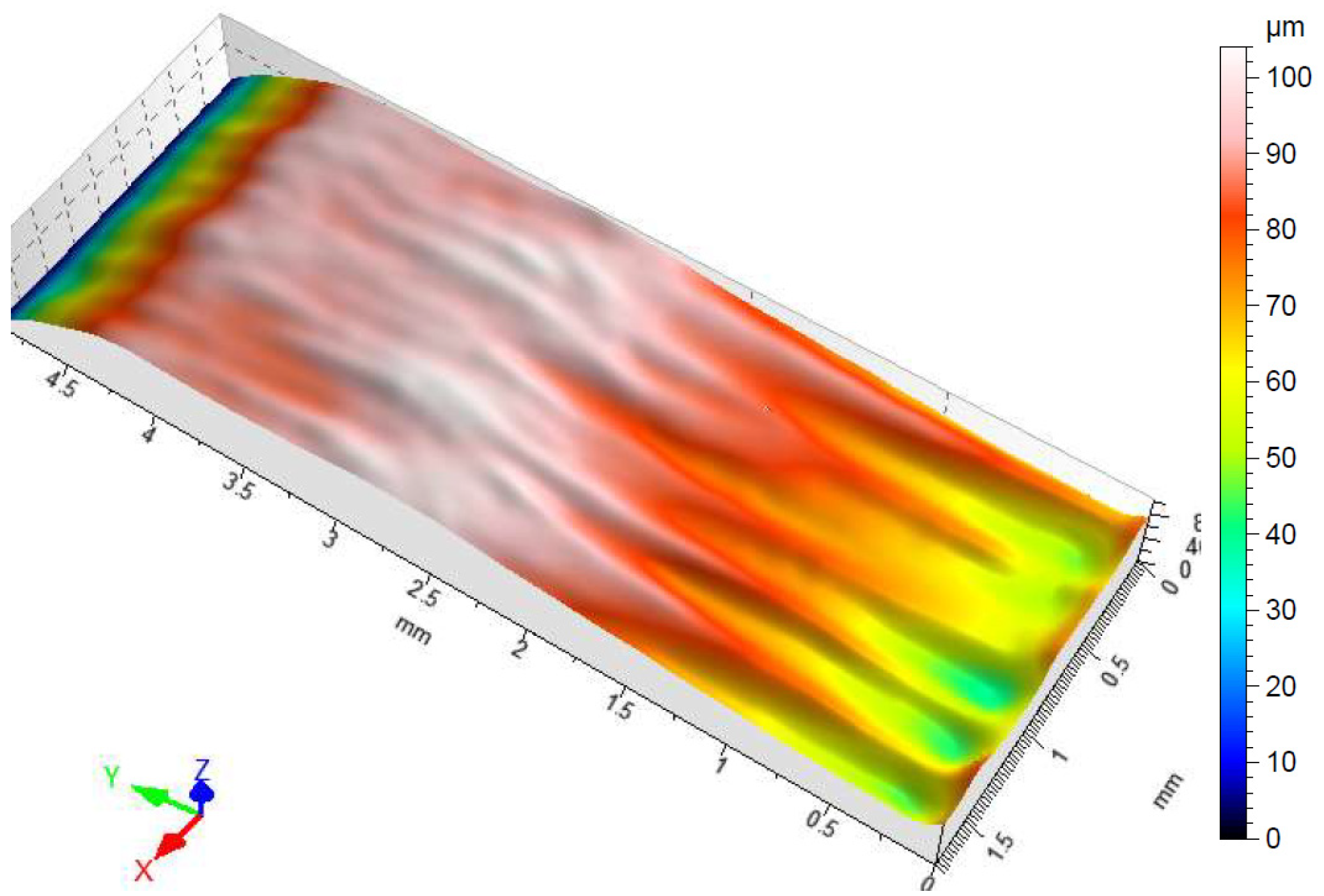
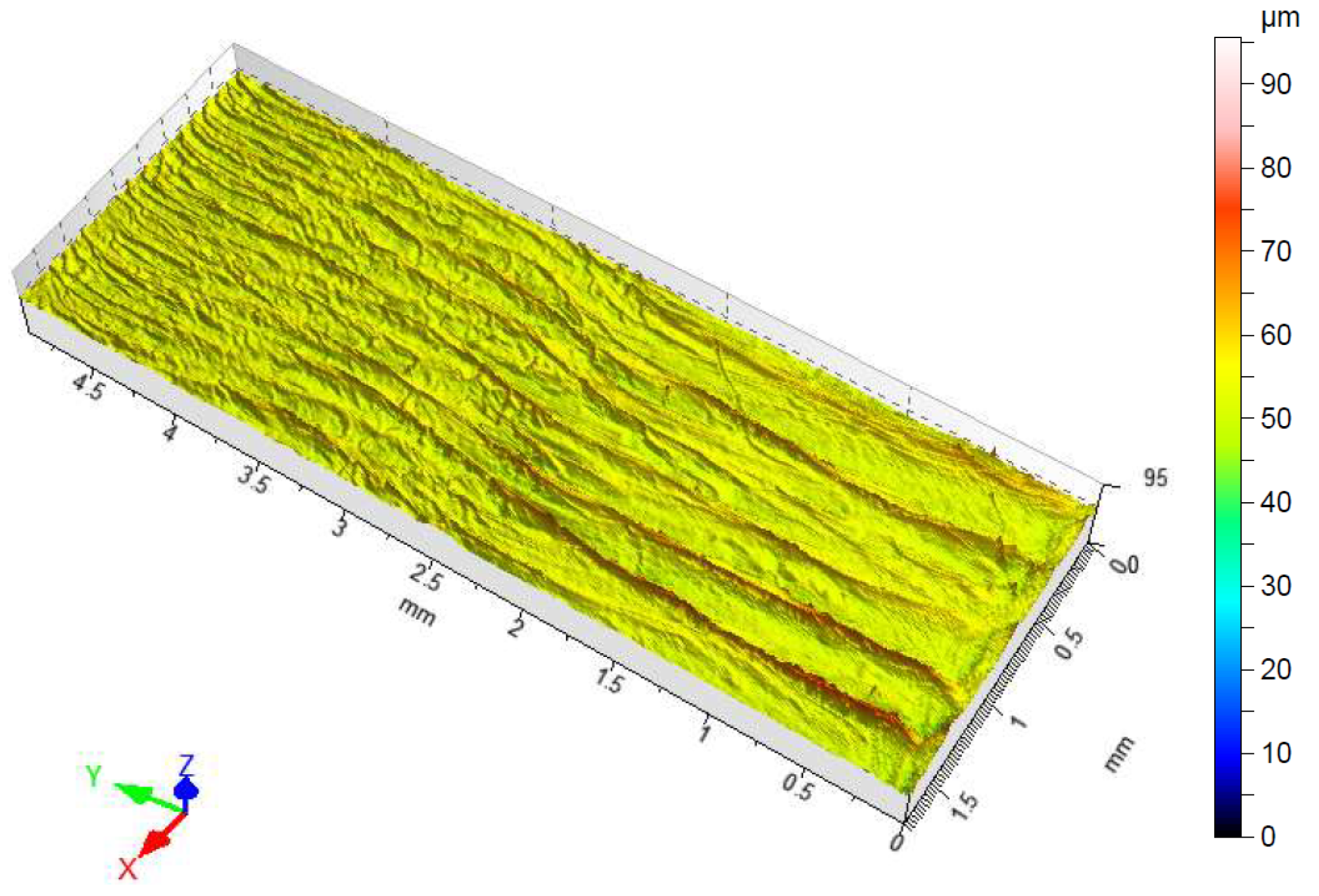
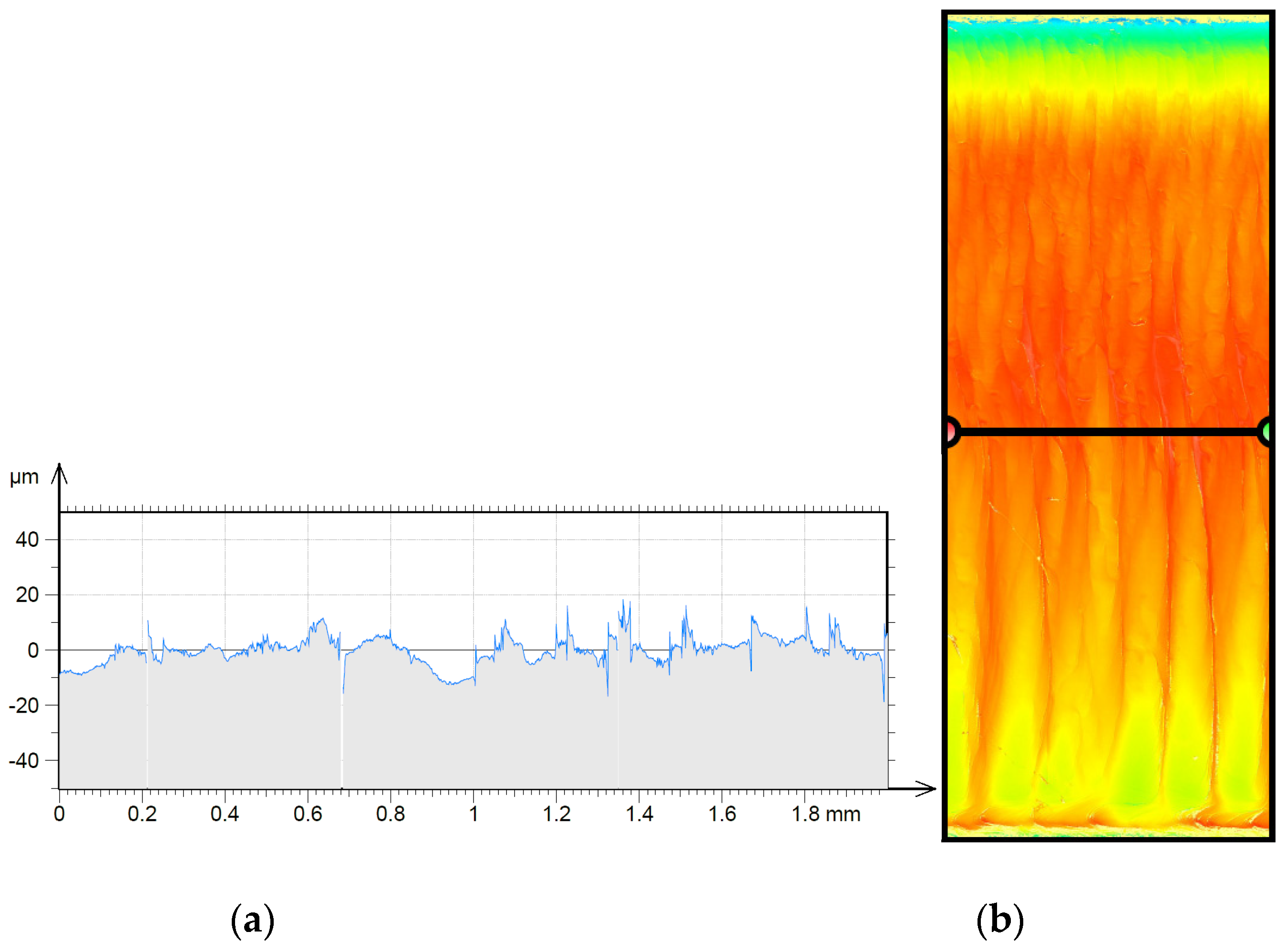

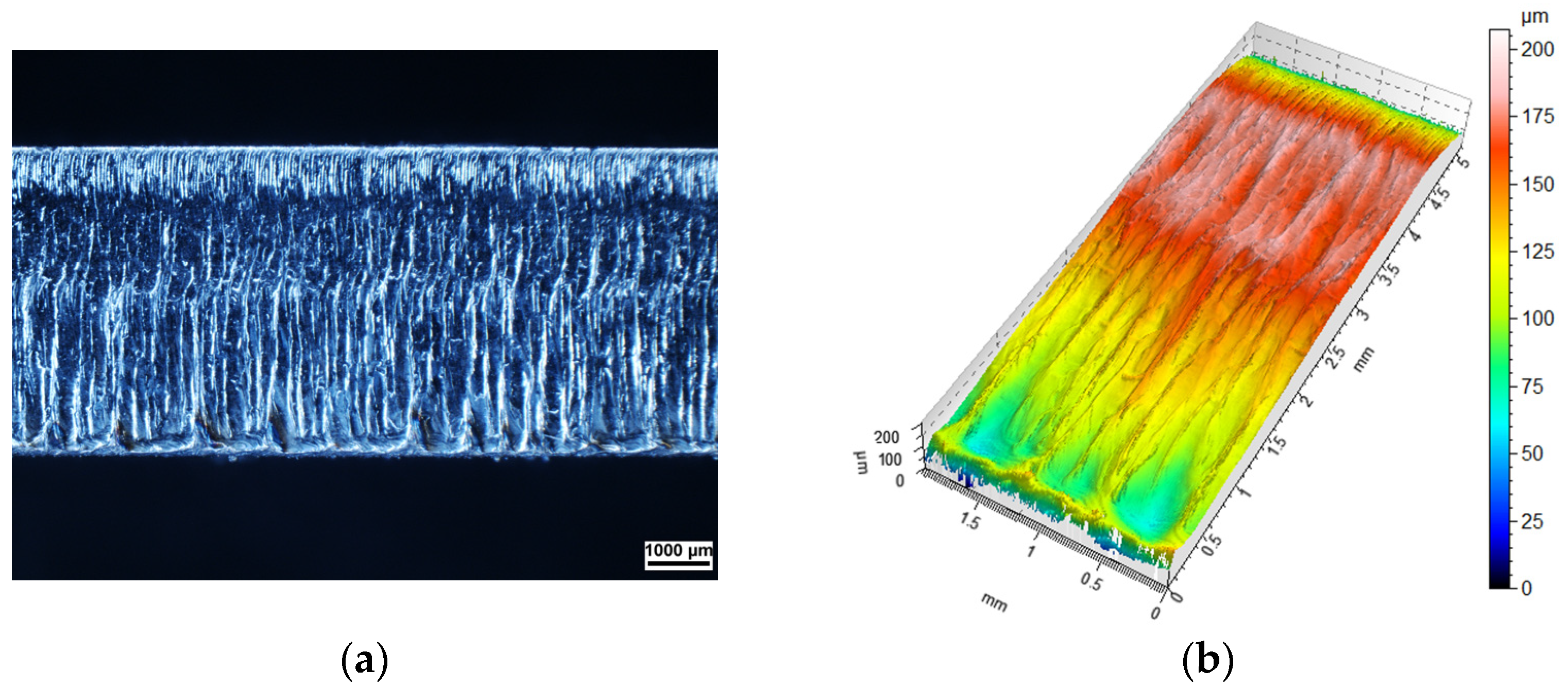


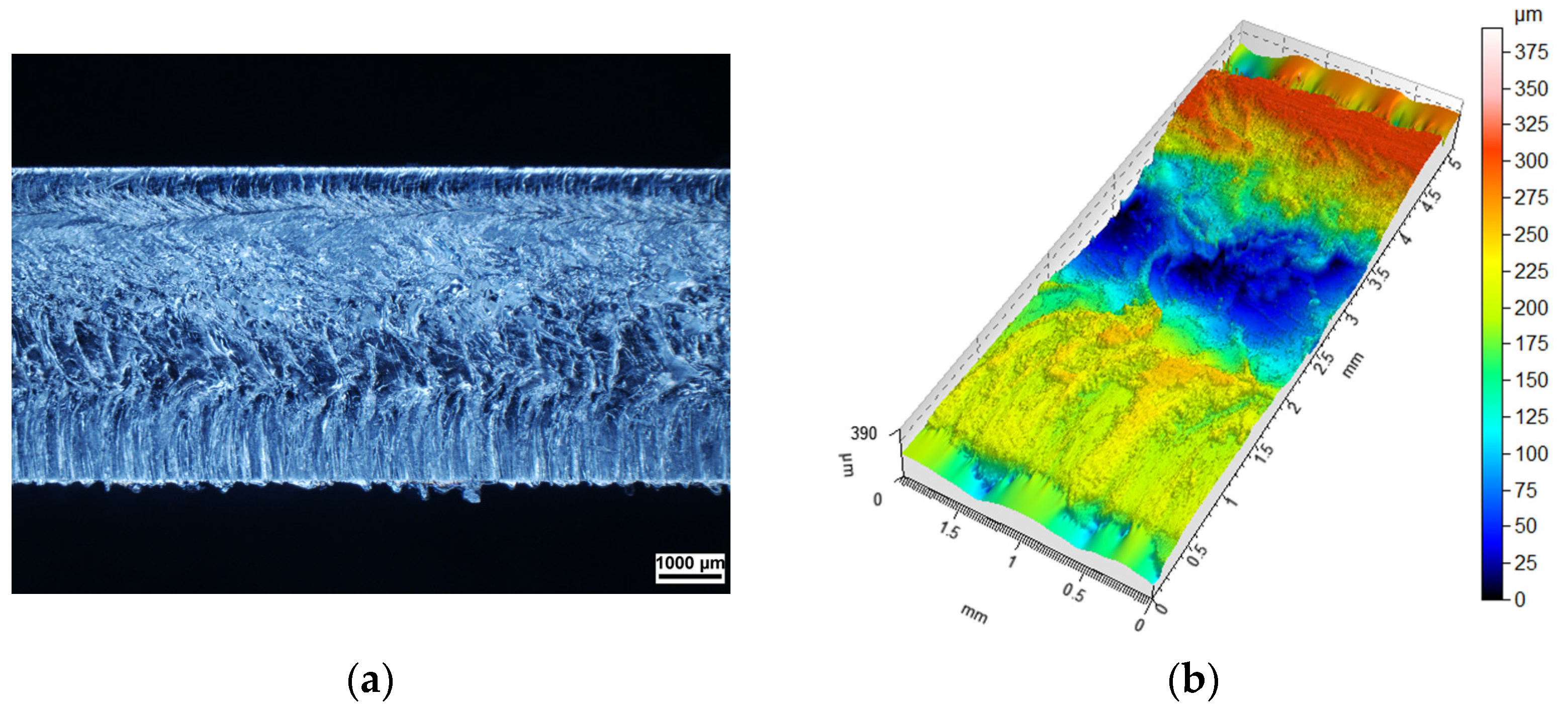


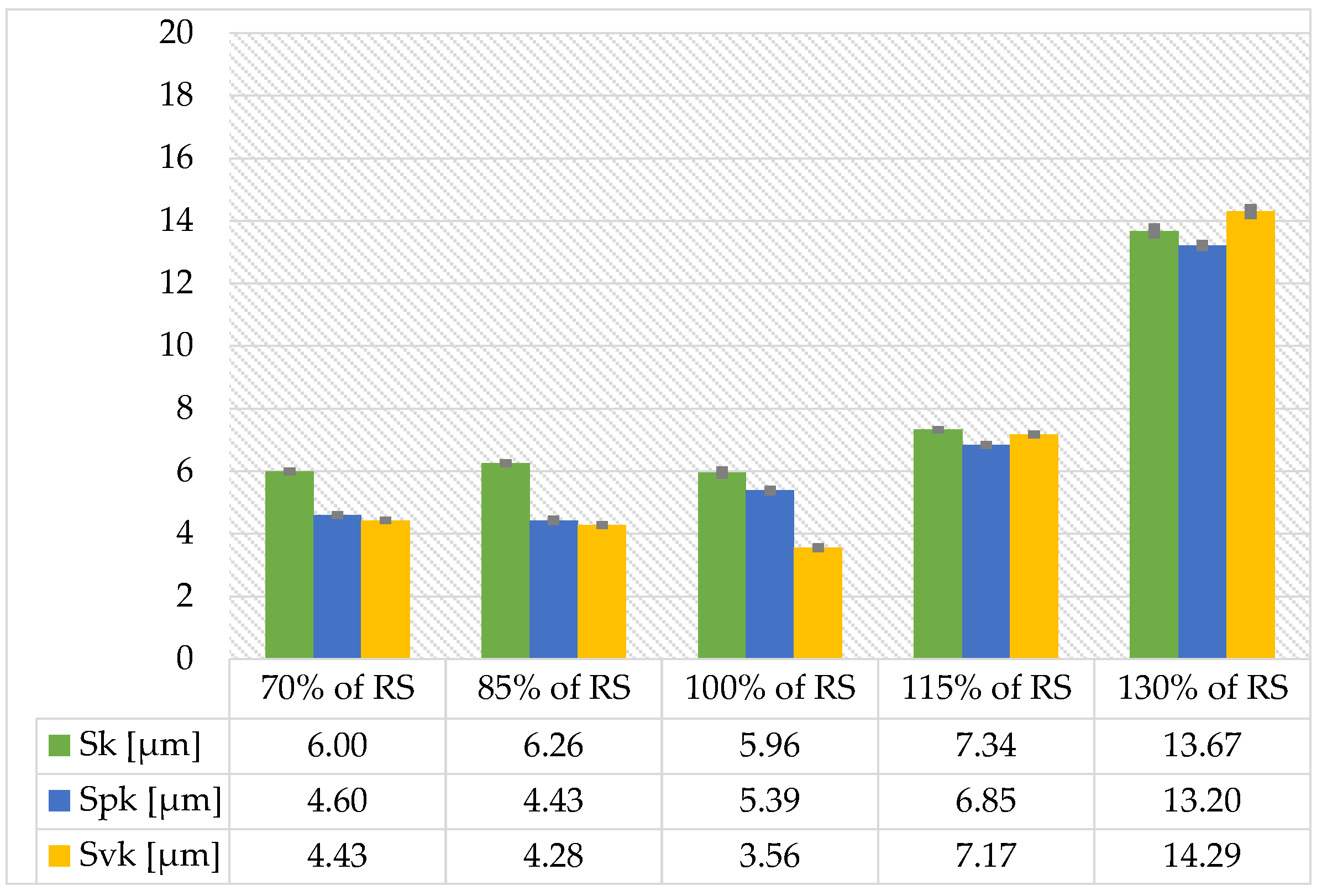

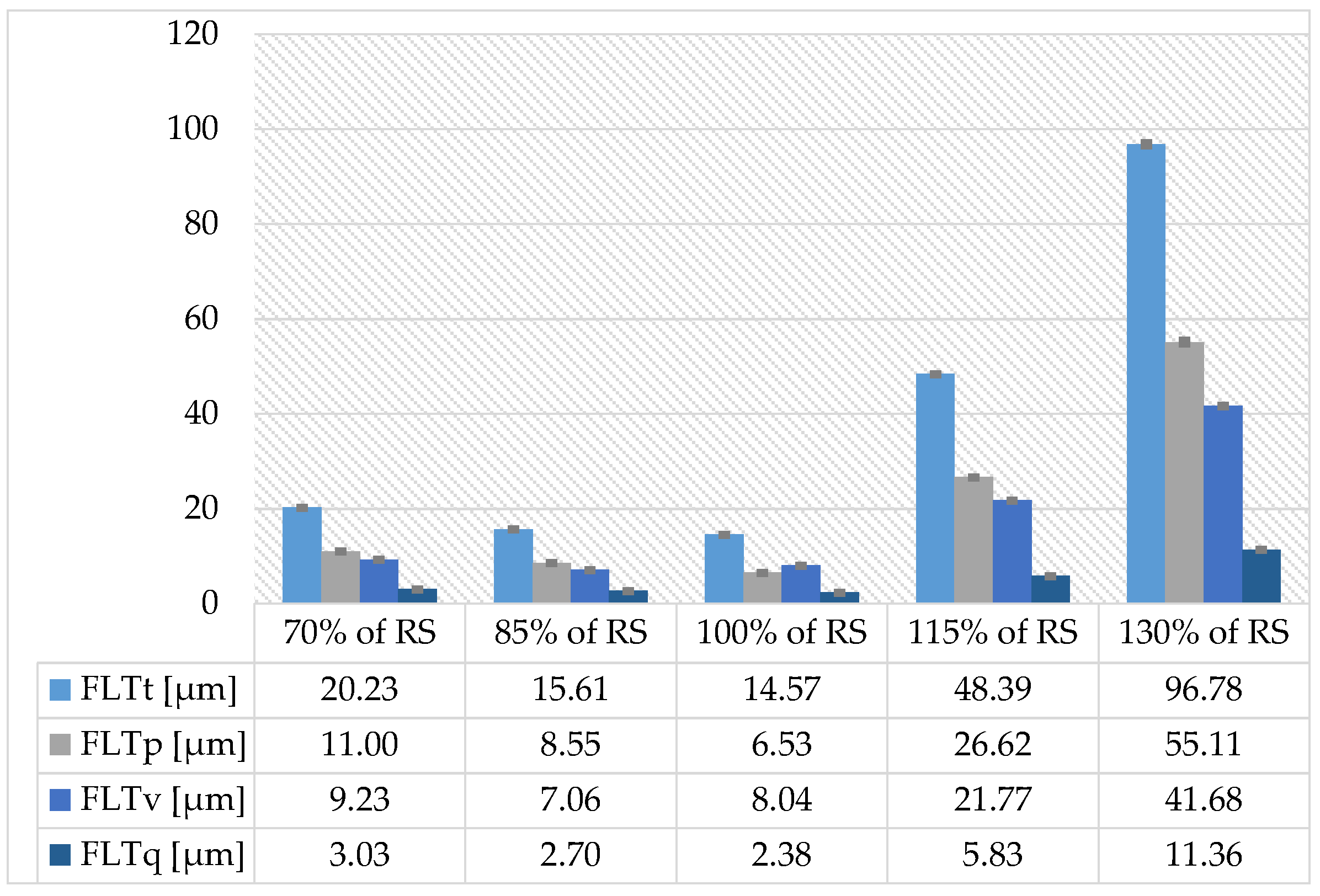
| Element Content, % by Mass | |||||||
|---|---|---|---|---|---|---|---|
| C | Mn | Si | P | S | Cr | Ni | Fe |
| 0.05 | 1.39 | 0.427 | 0.03 | 0.003 | 19.0 | 7.48 | |
| Cu | Al | Ti | Co | W | Mo | V | (rest) |
| 0.384 | 0.019 | 0.003 | 0.093 | 0.065 | 0.242 | 0.044 | |
| Sample No. | Re [MPa] | Rm [MPa] | A [%] |
|---|---|---|---|
| X5CRNI18-10—1 | 278 | 563 | 48 |
| X5CRNI18-10—2 | 285 | 561 | 47 |
| Sample No. | 1 | 2 | 3 | 4 | 5 |
|---|---|---|---|---|---|
| Cutting speed [mm/min] | 2450 | 2975 | 3500 | 4025 | 4550 |
| Laser power [W] | 4000 | 4000 | 4000 | 4000 | 4000 |
| Frequency [Hz] | 1000 | 1000 | 1000 | 1000 | 1000 |
| Gas pressure [bar] | 15 | 15 | 15 | 15 | 15 |
| Focal length [mm] | −1.5 | −1.5 | −1.5 | −1.5 | −1.5 |
| Sample thickness [mm] | 5 | 5 | 5 | 5 | 5 |
| Type of gas | nitrogen | nitrogen | nitrogen | nitrogen | nitrogen |
| 2D Parameters | |||||
|---|---|---|---|---|---|
| Rp [μm] | Rv [μm] | Rz [μm] | Rc [μm] | Rt [μm] | Ra [μm] |
| 10.7 | 9.82 | 20.5 | 10.7 | 32.4 | 2.3 |
| Rq [μm] | Rsk | Rku | RSm [mm] | Rdq [°] | RPc [1/mm] |
| 3.08 | 0.517 | 5.1 | 0.0487 | 54.4 | 20.8 |
Disclaimer/Publisher’s Note: The statements, opinions and data contained in all publications are solely those of the individual author(s) and contributor(s) and not of MDPI and/or the editor(s). MDPI and/or the editor(s) disclaim responsibility for any injury to people or property resulting from any ideas, methods, instructions or products referred to in the content. |
© 2022 by the authors. Licensee MDPI, Basel, Switzerland. This article is an open access article distributed under the terms and conditions of the Creative Commons Attribution (CC BY) license (https://creativecommons.org/licenses/by/4.0/).
Share and Cite
Krajewski, S.J.; Grochała, D.; Tomków, J.; Grzejda, R. Analysis of the Surface Stereometry of Alloyed Austenitic Steel after Fibre Laser Cutting using Confocal Microscopy. Coatings 2023, 13, 15. https://doi.org/10.3390/coatings13010015
Krajewski SJ, Grochała D, Tomków J, Grzejda R. Analysis of the Surface Stereometry of Alloyed Austenitic Steel after Fibre Laser Cutting using Confocal Microscopy. Coatings. 2023; 13(1):15. https://doi.org/10.3390/coatings13010015
Chicago/Turabian StyleKrajewski, Sławomir Janusz, Daniel Grochała, Jacek Tomków, and Rafał Grzejda. 2023. "Analysis of the Surface Stereometry of Alloyed Austenitic Steel after Fibre Laser Cutting using Confocal Microscopy" Coatings 13, no. 1: 15. https://doi.org/10.3390/coatings13010015
APA StyleKrajewski, S. J., Grochała, D., Tomków, J., & Grzejda, R. (2023). Analysis of the Surface Stereometry of Alloyed Austenitic Steel after Fibre Laser Cutting using Confocal Microscopy. Coatings, 13(1), 15. https://doi.org/10.3390/coatings13010015








